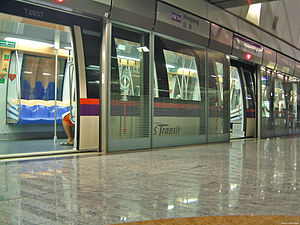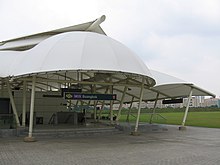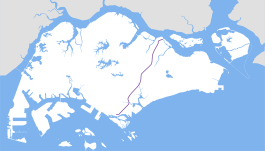North East MRT line
North East MRT line | |||
|---|---|---|---|
 | |||
 An Alstom Metropolis C751A train at Hougang Station on the North East line, the most crowded station on the line. | |||
| Overview | |||
| Native name | Laluan MRT Timur Barat 东北地铁线 வடக்கு கிழக்கு எம்ஆர்டி வழி | ||
| Status | Operational Under construction (Punggol Coast) | ||
| Owner | Land Transport Authority | ||
| Termini | |||
| Stations | 16 (excluding reserved station for NE2) 1 (Under construction) | ||
| Service | |||
| Type | Rapid transit | ||
| System | Mass Rapid Transit (Singapore) | ||
| Services | 1 | ||
| Operator(s) | SBS Transit | ||
| Depot(s) | Sengkang | ||
| Rolling stock | C751A C751C C851E (Future) | ||
| Daily ridership | 579,000 (Q1 2017) | ||
| History | |||
| Opened | 20 June 2003 15 January 2006 (Buangkok) 20 June 2011 (Woodleigh) 2023 (Punggol Coast) | ||
| Technical | |||
| Line length | 19.2 km (11.9 mi) (Operational) 1.6 km (0.99 mi) (Under construction) | ||
| Character | Fully underground | ||
| Track gauge | 1,435 mm (4 ft 8+1⁄2 in) standard gauge | ||
| Electrification | 1500V DC Overhead catenary | ||
| Operating speed | limit of 90 km/h (56 mph) | ||
| |||

The North East line (NEL) is a high-capacity Mass Rapid Transit line in Singapore. It runs from HarbourFront in the south-west to Punggol in the north-east. The line is currently 19.2 kilometres (11.9 mi) long with 16 stations,[1] and a full journey from one end to the other takes 33 minutes.[2] This line is coloured purple on the rail map. Being the third line in the Singapore MRT system, it was first opened on 20 June 2003. It is the first MRT line in the network to use fully automated and driverless trains,[3] and is also the world's first fully automated and driverless high-capacity rapid transit line to use conventional steel-wheel technology (as opposed to the rubber-tired, medium-capacity technology found in systems like VAL). The North East line is also the first line to feature Art in Transit across all 16 stations and full Wireless@SG coverage in all 16 stations. It is the first MRT line to be operated by SBS Transit. It is also the first MRT line to be entirely underground and all the stations on the North East line have island platforms.
Overview
As the name implies, the line connects central Singapore to the north-eastern and south-western parts of the island. It passes through busy areas such as Chinatown, Clarke Quay and Dhoby Ghaut (which have historical and cultural value), and through the mature and new residential estates at Potong Pasir, Serangoon, Hougang, Sengkang and Punggol.[1] The North East line passes through the Eu Tong Sen Street, Serangoon Road, Bendemeer Underpass, Upper Serangoon Road and the Upper Serangoon Viaduct. This line is the first in Singapore to be entirely underground and the first line to be operated by SBS Transit.
The North East line is the first line in Singapore to have artwork integrated into all its 16 stations under the Art in Transit programme.[1] Other than the Art in Transit programme, the interior architecture for the stations are typical of the design of the early 2000s with lots of white, glass and steel. This kind of design can be seen in other subway stations built during this period like the Shenzhen Metro and Hong Kong MTR's Tseung Kwan O line.
As of 2017[update], trains operate at two to three-minute intervals during weekday peak hours, four to five-minute intervals during weekday off-peak hours and three-and-a-half to five-minute intervals on weekends.[4]
History
The North East line dates back to 1986, where the Communications Minister Yeo Ning Hong had announced that it would be "feasible to extend the MRT once it is 3 million". The line would have gone from Punggol and Seletar/Jalan Kayu to Outram Park.
In the initial stages of planning, Outram Park was initially planned to be the southern terminus of the North East line. However, in 1993, the Land Transport Authority decided to extend the line southwards to HarbourFront, after noting that many people liked to go to the World Trade Centre (the present day HarbourFront Centre).
The Land Transport Authority received approval for the construction of the North East line on 16 January 1996, shortly after the plans were feasible once the Hougang Central Bus Interchange is already opened since 17 December 1994. French company Alstom was chosen as the main contractor and manager of the project. The operating license was given to new rail operator SBS Transit in order to foster competition with SMRT Trains. Construction began on 1 January 1997 and was completed on 20 January 2001, but all the stations had been completed with new signages.
The line was scheduled for completion in December 2002, but due to various problems in the automation, the opening was repeatedly delayed. It was finally opened on 20 June 2003, with higher fares than existing lines supposedly to compensate for the heavy construction costs (S$4.6 billion).

At the time that the line was opened, all of the stations were operating except Buangkok and Woodleigh. SBS Transit announced that these would open only when there was a critical mass of passengers in those areas. With respect to Buangkok, which had already been fully built, the company claimed that the projected number of passengers was too low to cover operating costs. Constant public pressure, notably the "White Elephant" incident and subsequent media attention, forced it to review the situation and the station duly opened on 15 January 2006. The last station on the line, Woodleigh, opened on 20 June 2011 in anticipation of an American International School which is under construction in the vicinity of the station that is slated to open in 2012.[5]
North East line extension
On 17 January 2013, a 2-kilometre extension which will run from Punggol through Punggol North including the new Punggol Downtown was announced. The extension will also serve the upcoming "creative cluster and learning corridor" in Punggol, which will include the Singapore Institute of Technology's new campus. It is expected to be completed by 2030.[6] However, the extension might be completed ahead of schedule due to the rapid development of Punggol North. Engineering consultancy studies have started for the extension.
On 7 June 2017, it was announced by Second Minister for Transport Ng Chee Meng that the North-East Line extension will open in 2023, 7 years ahead of the expected opening date. The single station extension will span 1.6km and will serve the future Punggol North area. The station is tentatively called Punggol Coast station.[7] Construction on the extension is expected to commence on the first half of 2018.[8]
Stations

| Station number | Station name | Image | Interchange/notes | Distance (km) | |
| Between stations | Total | ||||
| NE1 CC29 | HarbourFront |  |
Interchange with the Circle line | 0.0 | 0.0 |
| NE2 | Reserved station | (reserved for future use) | |||
| NE3 EW16 TE17 | Outram Park |  |
Interchange with the East West line and the Thomson-East Coast line (2021) | 2.6 | 2.6 |
| NE4 DT19 | Chinatown |  |
Interchange with the Downtown line | 0.7 | 3.3 |
| NE5 | Clarke Quay |  |
0.6 | 3.9 | |
| NE6 NS24 CC1 | Dhoby Ghaut |  |
Interchange with the North South line and the Circle line | 1.4 | 5.3 |
| NE7 DT12 | Little India |  |
Interchange with the Downtown line | 1.0 | 6.3 |
| NE8 | Farrer Park |  |
0.8 | 7.1 | |
| NE9 | Boon Keng |  |
1.2 | 8.3 | |
| NE10 | Potong Pasir |  |
1.6 | 9.9 | |
| NE11 | Woodleigh |  |
Most recent station to be opened. | 0.9 | 10.8 |
| NE12 CC13 | Serangoon |  |
Interchange with the Circle line | 1.2 | 12.0 |
| NE13 | Kovan |  |
1.7 | 13.7 | |
| NE14 CR8 | Hougang |  |
Future interchange with Cross Island Line | 1.5 | 15.2 |
| NE15 | Buangkok |  |
Station opened later on line. | 1.3 | 16.5 |
| NE16 STC | Sengkang |  |
Interchange with the Template:SLRT lines | 1.1 | 17.6 |
| NE17 PTC | Punggol | Interchange with the Template:SLRT lines | 1.6 | 19.2 | |
| North East line extension (Under construction) (Completion by 2023) | |||||
|---|---|---|---|---|---|
| NE18 | Punggol Coast | 1.6 | 20.8 | ||
The North East line's numbering scheme reserves station code "NE2" for future use.
Rolling stock

The rolling stock consists of Alstom Metropolis trains ordered under C751A and C751C contracts, running in six-car formation. These trains operate from Sengkang Depot near Buangkok station on the North East line. The Sengkang Depot has maintenance and train overhaul facilities for trains along the North East Line.
In 2010, the government announced that they would be looking to increase the number of trains on the North East Line by 70% within 5 to 6 years to cater to an expected increase in passenger traffic. 18 trains of six cars each were purchased under turnkey contract C751C and housed in Sengkang Depot. These train-sets have been on passenger service since 1 October 2015. [9][10]
The North East Line is the only line which uses a pantograph system for collecting power from overhead catenary; all other lines take power from a third rail.
In 2018, a further 36 rail cars (6 train-sets) were acquired to cater to the future extension of the line to Punggol Coast. [11]
Train control
The North East line is equipped with Alstom Urbalis 300 Communications-based train control (CBTC) moving block signalling system on the MASTRIA system with Automatic train control (ATC) under Automatic train operation (ATO) GoA 4 (UTO).[12] The subsystems consist of Automatic train protection (ATP) to govern train speed, Iconis Automatic Train Supervision (ATS) to track and schedule trains and Smartlock Computer-based interlocking (CBI) system that prevents incorrect signal and track points to be set.
Train Data Management System (TDMS) which concentrate and dispatch the rolling stock information with fixed equipment. The IAGO Waveguide communications network has the capability to transmit video and is almost maintenance-free. Base stations are located within the signalling equipment room.
Automatic platform screen doors supplied by Westinghouse provide safety for passengers, offering protection from arriving and departing trains.
Line disruptions
On 15 March 2012, more than 117,000 commuters were affected during a peak hour train breakdown between Dhoby Ghaut and HarbourFront, caused by faulty overhead power cables at the tunnel of the Outram Park that had snapped. A second problem was discovered relating to electricity insulation, delaying the service further. Train services resumed at 4.35 pm after nearly 10 hours of disruption making it the third breakdown in 4 months.[13][14][15] Subsequently, the Land Transport Authority (LTA) intends to impose financial penalties amounting to S$400,000 on SBS Transit for the train service disruption along the North East line on 15 March 2012.[16]
On 13 October 2015, train service was disrupted between Farrer Park and Hougang for more than half an hour due to a power fault. It was triggered by a malfunction of a component in the electrical switchgear at a substation which caused the main circuit breaker to trip. As an interim measure, SBS Transit has increased the protection setting of the circuit breaker to cater for the projected maximum load of the network.
On 26 October 2015, about 41,000 commuters were affected during morning peak hour when a power fault crippled the whole line from Punggol to Harbourfront stations. This is the first time that both the north- and south-bound service are affected which resulted in the mobilization of about 100 free shuttle buses across the NEL. The Alstom Metropolis C751C train was returning to the Sengkang Depot when the driver saw sparks from above the train and stopped the train at a stretch where the mainline and depot catenary system wires overlap. This resulted in arching between the wires of the mainline and the depot. This caused the catenary system wires to melt and eventually snap. As a precautionary measure, SBS Transit has marked non-stopping areas at all overlapping zones and reduced electrical voltage difference between the catenary system wires at the overlap point, in case trains stop at this stretch.[17]
See also
External links
References
- ^ a b c "North East Line". Land Transport Authority. Retrieved 22 June 2017.
- ^ Travel Time, SBS Transit
- ^ "Singapore Northeast Line" (PDF). Alstom.
- ^ "First/Last Train Info". SBS Transit. Retrieved 22 June 2017.
- ^ "Train finally arrives at Woodleigh MRT station". Channel NewsAsia. 20 June 2011. Retrieved 11 May 2012.
- ^ "TWO NEW RAIL LINES AND THREE NEW EXTENSIONS TO EXPAND RAIL NETWORK BY 2030". Land Transport Authority. 17 January 2013. Archived from the original on 6 July 2014.
{{cite web}}: Unknown parameter|deadurl=ignored (|url-status=suggested) (help) - ^ "New train station in Punggol North by 2023". Channel NewsAsia. 7 June 2017.
- ^ "North-East Line extension serving Punggol North to open in 2023 instead of 2030; to cater to developments in the Punggol area". The Straits Times. 7 June 2017. Retrieved 28 October 2017.
- ^ "LTA and SMRT Award Contracts for New Trains and Re-Signalling Project". Land Transport Authority. 1 February 2012. Archived from the original on 29 September 2013. Retrieved 16 November 2013.
{{cite web}}: Unknown parameter|deadurl=ignored (|url-status=suggested) (help) - ^ "Alstom to supply 34 Metropolis trains and signaling upgrade to Singapore metro". 3 February 2012. Archived from the original on 31 December 2013. Retrieved 16 November 2013.
{{cite web}}: Unknown parameter|deadurl=ignored (|url-status=suggested) (help) - ^ "Alstom to supply 17 additional Metropolis trains for Singapore Circle Line and North East Line | The French Chamber of Commerce in Singapore". www.fccsingapore.com. Retrieved 9 August 2018.
- ^ "Singapore Northeast Line". Retrieved 21 August 2016.
- ^ "NEL's Dhoby Ghaut – Habourfront service resumes".
- ^ "Full train service on NEL resumed at 4:35 pm: SBS Transit". Yahoo! Singapore. 15 March 2012. Retrieved 15 March 2012.
- ^ "Joint News Release by Land Transport Authority and SBS Transit – North East Line Train Service Resumes Full Operation Following Morning Disruption". Land Transport Authority. Retrieved 15 March 2012.
- ^ "SBS Transit fined S$400,000 for March train disruption". Channel NewsAsia. 4 September 2012.
- ^ "NEL train disruption on Oct 26 caused by melted wires which snapped, say SBS Transit & LTA". Straits Times. 27 November 2015.
Template:North East MRT line navbox

